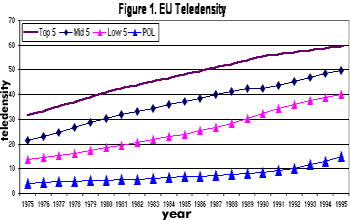
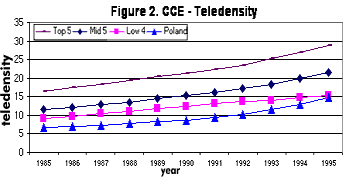
Many countries are rapidly modernizing telecommunications as part of an overall effort to provide the products and services to aid its domestic businesses in competing more effectively in the global market. Nations require a well-developed telecommunications system in order to grow domestically and attract and retain multinational organizations. By benchmarking telecommunications, we compare the focal country's telecommunications infrastructure to that of other countries and draw conclusions concerning the effectiveness of its telecommunications policies. We have used a basic diffusion model to also draw policy implications concerning the pace of telecommunications infrastructure development.
Poland was chosen as the focus for this study since it's one of the most important and largest developing countries in Central and Eastern Europe. Its economy is robust by CEE standards and is being transformed from one that was centrally planned to one that is market-oriented. Poland's telecommunications sector languished for years under Soviet domination. The pent-up demand for services is reflected by the rapid growth that has occurred in that country since 1989, when Soviet domination ended. Bench-marking statistics are presented to show how Poland, as well as most of its CEE neighbors, dramatically changed telecommunications infrastructure development since the socialist period.
We also compare Poland's level of telecom development with European Union (EU) countries and draw additional policy lessons from that. While telecom in the EU countries is clearly well ahead of that in Poland, there are two reasons for this comparison:
In this article, we use the benchmarking paradigm to compare one country's telecommunications sector to those of other countries in the comparison set. During most of the period under review, there was only one telecom company in the countries we studied, the state owned-and-operated monopoly. Recently, some of these countries have privatized telecom and/or opened the door to competition. Even where there are two or more telecom companies, the information source we used aggregated data at the country level. Conclusions derived from this analysis will apply only to the country as a whole. In this way, we are able to observe how the target of the study measures up to relevant groups. Readers may gain a new perspective based on this quantitative assessment.
Benchmarking has limits. The comparisons are based on broadly aggregated indices. However, there may be significant organizational or environmental differences that are hidden by the level of this analysis. For example, currency fluctuations are not uniform across countries. The reader must be mindful of this situation when drawing conclusions from the data and analysis presented herein.
Only Hungary, with a rate of 14.1%, was greater. The popular media considers Hungary, the Czech Republic, and Poland as the most "Western" among the CEE countries. These three are the only CEE countries under consideration for entry into NATO. We selected Poland out of this group since it has nearly four times the population of either of the other two, and its telecom infrastructure is less well developed (e.g., 1995 teledensity: Poland = 15 versus Hungary = 19 and Czech Republic = 24).
Poland is planning the first phase of privatization of its state-owned telephone operator (TPSA) in 1998. With the largest population and a less well-developed telephone system, Poland offers investors and strategic partners the greatest opportunity in terms of unrealized market potential. The benchmarking done in this article may be useful to those who are interested in Polish telecom including regulators, operators, and manufacturers, as well as academics. Furthermore, this technique can be used for any country; Poland is simply an interesting case study.
We believe this study is unique in that it uses longer time series than those in other papers reviewed in our literature search. This permits analysis of trends rather than using a snap shot approach of only one or several recent years of data.3 We have constructed three groups each of EU and CEE countries. Poland is compared to a total of six relevant groups of countries over at least 10 years in order to determine its standing in both east and west.
In the subsequent sections, we present various benchmarking comparisons. In all cases, we show two sets for each parameter: Poland versus EU countries and Poland versus CEE countries. On each chart, Poland is compared to three sets of data representing the average of the countries in the high, medium, and low set. Each section will contain interpretation of the data in support of the quantitative measures that are shown graphically.
| Table 1 EU & CEE Country Comparison Groups | ||||
|---|---|---|---|---|
| European Union | Central & Eastern Europe | |||
| Country | 1995 Teledensity | Country | 1995 Teledensity | |
| High | Sweden Denmark Luxembourg France Finland | 68 61 56 56 55 | Slovenia Bulgaria Latvia Estonia Croatia | 31 31 28 28 27 |
| Mid | Netherlands UK Greece Germany Austria | 53 50 49 49 47 | Lithuania Czech Republic Slovak Republic Yugoslavia Hungary | 25 24 21 19 19 |
| Low | Belgium Italy Spain Ireland Portugal | 46 43 39 37 36 | Belarus Ukraine Poland Moldova Romania | 19 16 15 13 13 |
| Source: ITU World Telecom Indicators, 1996 | ||||
In the authors' opinion, wireless will soon need to be included in teledensity studies as it becomes an equal partner with wireline service. That was not the case during the period of comparison.
The next two graphics illustrate teledensity for the EU and CEE countries and Poland. In Figure 1, the teledensity of Poland lags behind EU countries, which is not surprising since telecommunications was not a priority in Poland under the Communists. At the start of the time series, the Low 5 EU group was approximately where Poland was 20 years later (teledensity of 15). From 1975 until 1990, teledensity in western countries was increasing at a steady pace, while that of Poland was nearly flat. A dramatic change started in 1990, the first full year after the collapse of the Soviet bloc. The radical nature of this shift is more obvious in subsequent graphs where the teledensity range is smaller. Yet, in 1995, Poland's teledensity was still far behind that of the EU countries (15 versus 60). Later, we examine the rate of change in teledensity. By so doing, we will be able to identify the distinct phases of growth that have been experienced by the EU countries and draw additional comparisons to Poland.


Next, we compare Poland's teledensity to that of the CEE countries (Figure 2). Poland was below the teledensity for the CEE countries until the last year in the series, 1995, when it reached the average of the "low" group. In 1985, the teledensity in Poland was approximately 7, less than half the average for the top group of CEE countries. From 1991 forward, Poland accelerated its telecom development and began to close the gap with the low group.
This can be seen in Figure 1 for the Top 5 countries where the curve is turning down toward the end of the period, indicating a maturing market. This slowdown can result from a substitution effect which, in the case of telecom, may be caused by the introduction and rapid acceptance of wireless in the most developed nations. Poland, by contrast, experienced a very long first phase due to the security policy of the Communist regime. During the 1990s, it is entering the second phase with strong, pent-up demand and a government that is dramatically increasing its investment in telecom. Due to the late start, the diffusion process in Poland may be more rapid than for its counterparts in the West. The substitution effect of wireless can be expected to cause the wireline diffusion process to enter the third phase at a lower level of teledensity than in the EU countries.
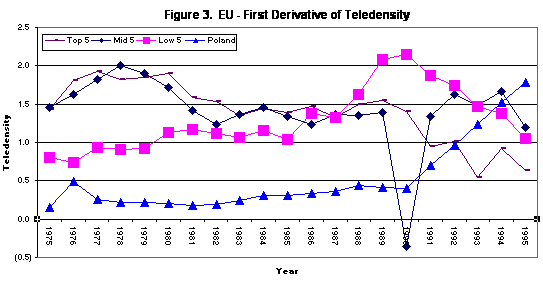
Second, by using this technique, we can show the diffusion process in action. Notice the shape of the curves for the EU countries. Each one has a distinct maximum representing the point on the teledensity curve where the rate of change goes from acceleration to deceleration or the point of inflection. This is further evidence of a diffusion process. The Top 5 reached a maximum in 1977 and the Mid 5 in 1978. The Low 5 did not peak until 1990. In contrast, Poland has a long flat curve followed by a very steep ramp-up as it moves from the first to second phase of diffusion.
Using diffusion theory, we expect that the rate of change for Poland will slow down and eventually reach a maximum. From empirical observation, we note that, in 1995, Poland's rate of change in teledensity was 1.8. In the 20-year history of the EU countries shown in this study, the maximum rate was in the range of 2.0. Poland should have reached that range in 1996. If history can be trusted, we would expect to see Poland's rate of change level off at about 2.0 and drop slightly in the next few years to a pace of 1.2 to 1.5 per year.
Figure 3 shows the diffusion process that has taken place in the development of the telecom infrastructure over time. The first phase is characterized by a flat rate of change for the teledensity followed by a rapid increase during the second phase. When the peak is reached, we expect the rate to become more moderate.
There is a striking anomaly in this data set in 1990 for the Mid 5 EU countries. That was the year German reunification was reflected in the ITU data. The ITU merged the data on teledensity from West and East Germany into a single entity, which produced the effect of lowering German teledensity from 46.5 in 1989 to 40.2 in 1990. Although not reported separately by the ITU, East Germany must have had a teledensity of 18.1 before reunification, placing it in the Low 5 of the CEE countries. This is the only case where the rate of change of teledensity is negative.
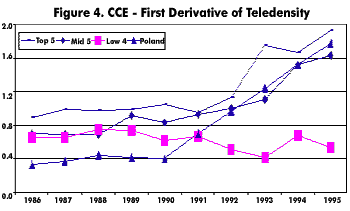
Figure 4 shows the same analysis for the CEE countries. During the years of Soviet dominance in CEE, the change in teledensity is almost flat for all four plots. Clearly, Poland is substantially below the lowest group, indicating the total lack of interest in telecommunications development prior to the end of Soviet dominance. Note that Poland passed the lowest group in 1991 and has a slope approximately that of the top two groups.
Historically, the industry has been very labor intensive. Productivity gains are made by increased use of technology and by changing management's focus on productivity. The latter factor may be addressed by one or more of these approaches:
A benchmarking study provides a developing country's telecom policy makers with a basis for setting productivity goals. Undoubtedly, many developing countries have done that in preparation for obtaining financing, planning for privatization, and developing strategies for strategic alliances.
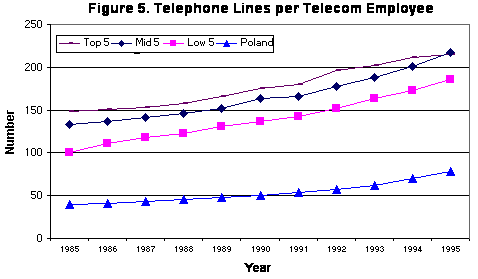
The good news is that Poland is increasing worker productivity in an absolute sense as summarized in Table 2. The work force is not growing as rapidly as is the number of access lines, that is, the number of main lines increased by a much greater extent than did the work force.
Worker productivity is moving in the right direction, but it has a long way to go to compare with that of any EU country. The following example puts Poland's dilemma in perspective.
This analysis dramatizes the position in which Poland finds itself. The strides that Poland has made since 1990 must be sustained over an extended period of time to close the gap with EU countries. This is a daunting task. An alternative approach for Poland and other developing countries is to shift to wireless, which is less labor and capital intensive and faster to deploy.
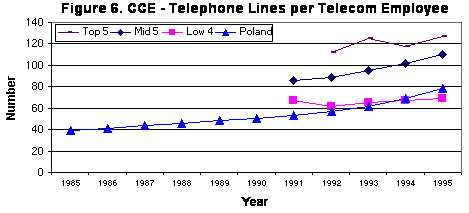
Next, we compare telecom worker productivity in Poland to its neighbors in the CEE. Poland surpassed the average of the Low 4 CEE countries in 1994 and, by 1995, was slightly ahead of this group. The comparison with the other two CEE groups, however, is not as favorable. As seen in Figure 6, the slope for Poland is about equal to that of the Top 5 and Mid 5 CEE countries. This means that the gap remains constant. In a recent article, David Rocks7 stated that Poland's neighbors -- Hungary and the Czech Republic -- are significantly ahead of Poland according to this measure.
Second is measuring telecom revenue. The telecom sector is notorious for using subsidies to implement public policy. In most countries, the price of local service is held at or below cost while long distance, both domestic and international, is priced well in excess of costs. In developing countries, low interest loans and grants from international agencies and other shifts in a country's public funding for telecom may distort the revenue picture for intercountry benchmarking. Yet, we use the data for country to country comparisons. Both factors represent limits in our ability to benchmark these dimensions effectively. While more sophisiticated modeling could be done, we believe that an adequate benchmarking analysis can be accomplished with the ITU data in spite of these limitations.
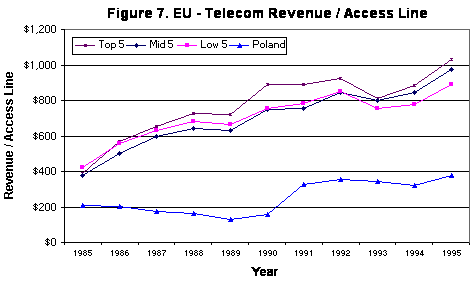
In Figure 7, we show revenue per access line. On the surface, Poland appears much lower than the EU countries. However, when we consider the differences between GDP per person, the relationship changes. For example, in 1995, the average GDP per person for the Top 5 EU countries was $25,016, while it averaged $2,415 for Poland, a ratio of approximately 10:1. On the other hand, revenue per access line for the Top 5 EU countries was $1,033, and Poland's was $377 or 2.7:1. If we adjust the numbers based on the difference in GDP per person, Poland's revenue per access line is considerably more than that of the EU countries.
Poland's telecom revenues in comparison to its CEE peers is very favorable. Since GDP per person displays a greater similarity among the CEE countries than between Poland and the EU countries, this may be a more useful comparison than with the EU countries. Poland's position on this measure is outstanding; however, potential shortcomings remain as mentioned earlier.
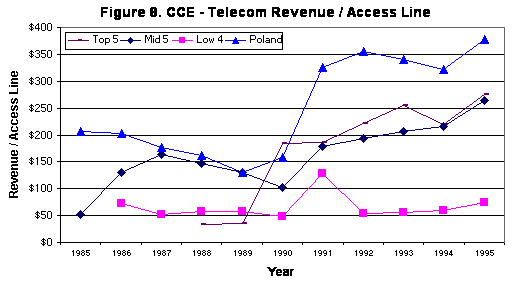
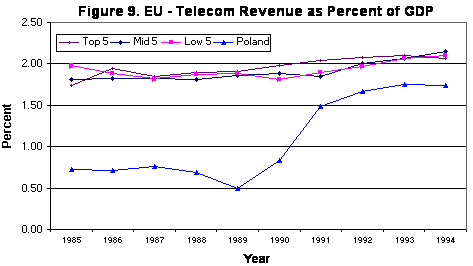
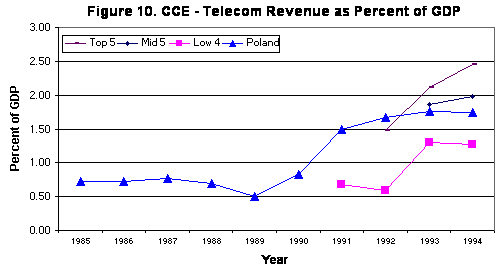
The data is more sparce for the CEE countries, as seen in Figure 10. There are only two years (1993-1994) for which we have data for all four sets in this benchmarking group. Poland is below both the Top 5 and Mid 5 comparison groups, which is consistent with its place in most other measures. We should note that the Top 5 CEE countries exceed the Top 5 EU countries on this measure, which means that Poland does not have to feel constrained to the 2% maximum that is derived from the EU analysis.
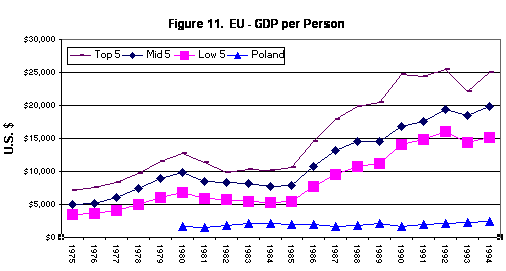
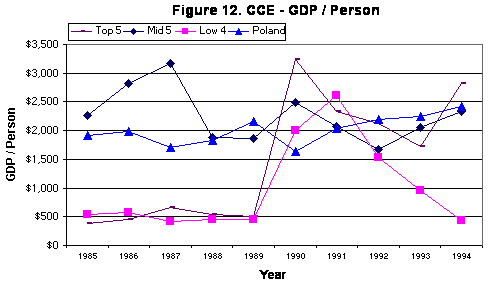
When we compare the GDP per person for the CEE countries and Poland, we find a much narrower range in that variable. Figure 12 shows that Poland and the top two comparison groups of CEE countries are comparable, which indicates Poland is not disadvantaged. This measure is subject to the vagaries of general economic fluctuation that takes place between countries with different currencies and ever-changing exchange rates.
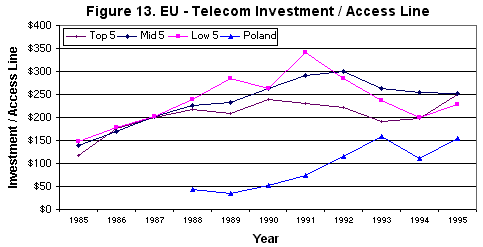
You will note an interesting characteristic in this data. During the period of 1988-1990, the Low 5 EU countries were making a heavier investment per access line than the Top 5. This inversion suggests that the Low 5 were attempting to catch up with their peer group.
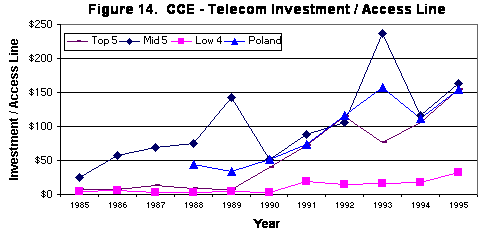
In Figure 14, we see that Poland is making an investment per access line that is very close to the average of the Top 5 and Mid 5 CEE countries, and nearly four times that of the Low 4. Based on this analysis, Poland seems to be positioned well on this dimension.
The change from a system of government controls and management of the telecommunications system to one with profit incentives resulted in a radical change in the teledensity growth. In Poland, this change was not caused by the introduction of significant levels of competition. The market structure has remained almost a total monopoly.8 The change has been largely due to the change in incentives for the management of the telephone system.
Beyond the clear policy direction favoring free market incentives, market structure recommendations are less definitive. We have shown evidence that the slower pace for introducing competition into the Polish market very likely resulted in slower teledensity growth than would have been the case if more aggressive policies promoting competition had been implemented. Both Hungary and the Czech Republic instituted policies that encouraged greater competition compared with Poland, and teledensity growth was higher. Other economic and demographic factors may have also contributed to teledensity differences between these countries such as differences in income levels, level of foreign investment in the telecom sector, and general economic conditions.
Finally, the benchmarking and diffusion analysis comparing telecom development in Poland with the EU countries shows that Poland should not simply adopt policies which place the country on a similar path as the EU. Our recommendation is that policies within Poland must accelerate telecom development in order to close the gap with the EU countries. Technology may provide the means for this accelerated development through wireless and fiber optic deployment, but policies must encourage greater competition and foreign investment. Present policies, which are bringing about gradual change and the prospects for a continued monopoly market structure, do not appear to provide sufficient economic incentives for Poland to close the gap in telecom development with the EU.